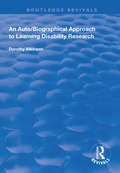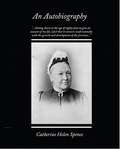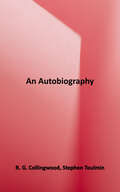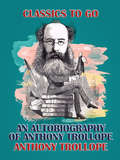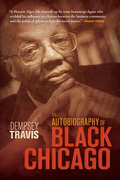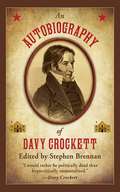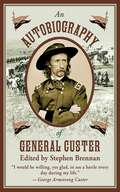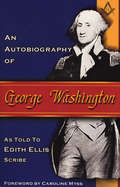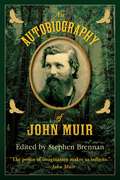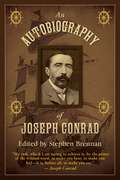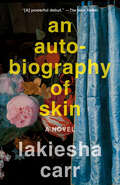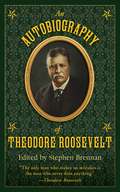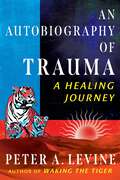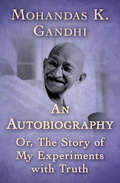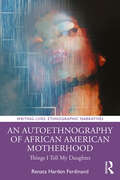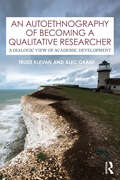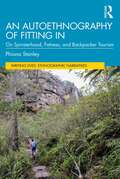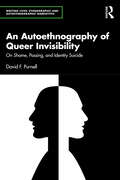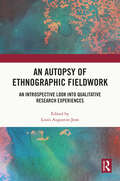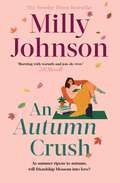- Table View
- List View
An Auto/Biographical Approach to Learning Disability Research (Routledge Revivals)
by Dorothy AtkinsonFirst published in 1997 , Dorothy Atkinson collects testimonies of the personal perspectives of people with learning disability in order to rediscover the histories of people with learning disabilities. Calling on the importance if auto/biographical research as mode to encourage social, historical awareness and potential understanding of the commonalities as well the differences between people with learning difficulties.
An Autobibliography by John Caius (Routledge Early Modern Translations)
by Vivian NuttonJohn Caius (1510–1573), second founder of Gonville and Caius College, Cambridge, was an English scholar with an international reputation in his lifetime as a naturalist, historian and medical writer. His Autobibliography is a major contribution to the history of English culture in the middle years of the sixteenth century and has been translated into English for the first time in this book. Beginning with an in-depth introduction to John Caius’ life and works, An Autobibliography by John Caius provides a wealth of information to support and accompany the translation of this significant text. In his Autobibliography, Caius lists the books that he wrote but also details the circumstances of their writing. He describes his travels in Italy in search of manuscripts of the ancient Greek doctor Galen of Pergamum as well as giving an insight into his personal life, including his vigorously conservative views, whether on medicine, spelling and pronunciation, or on Cambridge University. His religious views, which led to the ransacking of his rooms by a Cambridge mob, are explored in detail in Appendix II of this book. In Appendix I, recent discoveries of books owned and annotated by Caius are used to supplement what he says about his activities, as well as to trace at least one of his lost works in Italy and Denmark. The resulting picture throws light on European medicine in the sixteenth century, as well as on the humanistic culture that linked learned men and women across Renaissance Europe.
An Autobiography
by Catherine Helen SpenceSitting down at the age of eighty-four to give an account of my life, I feel that it connects itself naturally with the growth and development of the province of South Australia, to which I came with my family in the year 1839, before it was quite three years old. <P> <P> But there is much truth in Wordsworth's line, "the child is father of the man," and no less is the mother of the woman; and I must go back to Scotland for the roots of my character and Ideals. I account myself well-born, for My father and my mother loved each other. I consider myself well descended, going back for many generations on both sides of intelligent and respectable people. I think I was well brought up, for my father and mother were of one mind regarding the care of the family. I count myself well educated, for the admirable woman at the head of the school which I attended from the age of four and a half till I was thirteen and a half, was a born teacher in advance of her own times. In fact. like my own dear mother, Sarah Phin was a New Woman without knowing it. The phrase was not known in the thirties
An Autobiography
by R. G. CollingwoodThis early work by Robin G. Collingwood was originally published in 1939 and we are now republishing it with a brand-new introductory biography. 'An Autobiography' is the story of Collingwood's personal and academic life. Robin George Collingwood was born on 22nd February 1889, in Cartmel, England. He was the son of author, artist, and academic, W. G. Collingwood. He was greatly influenced by the Italian Idealists Croce, Gentile, and Guido de Ruggiero. Another important influence was his father, a professor of fine art and a student of Ruskin. He published many works of philosophy, such as Speculum Mentis (1924), An Essay on Philosophic Method (1933), and An Essay on Metaphysics (1940).
An Autobiography of Anthony Trollope (Classics To Go)
by Anthony TrollopeTrollope left the manuscript of his autobiography in a desk drawer with instructions for his son Henry on publishing it after his death. The autobiography is immensely fun to read. It would be best if you could hold off until you've read the 30-some-odd novels he had written before he wrote the autobiography. But who can wait that long? (Goodreads)
An Autobiography of Black Chicago
by Dempsey TravisFew were more qualified than Dempsey Travis to write the history of African Americans in Chicago, and none would be able to do it with the same command of firsthand sources. This seminal paperback reissue, An Autobiography of Black Chicago, emulates the best works of Studs Terkel - portraying the African American Chicago community through the personal experiences of Dempsey Travis, his family, and his fellow Chicagoans. Through his family's and his own experiences, plus those of the book's numerous well-respected contributors, Travis tells a comprehensive, intimate story of African Americans in Chicago. Starting with John Baptiste Point du Sable, who was the first non-Native American to settle on the mouth of the Chicago River, and ending with Travis's successes providing equal housing opportunities for Chicago African Americans, An Autobiography of Black Chicago acquaints the reader with the city's most prominent African American figures - told through their own words.
An Autobiography of Davy Crockett
by Stephen BrennanBased in part on Davy Crockett's own writings, this is the true story about one of America's most iconic historical figures. From his days as a scout for Andrew Jackson during the war of 1812, his time as a Congressman for the state of Tennessee, and his eventual death at the Alamo, Davy Crockett led a life that was admired and idealized by people all across America, to this very day. Read about the monopolist and corporate misdeeds, environmental degradation, and foreign military adventures that he experienced during his amazing life. Illustrated with drawings and photos, discover the rich history-part myth and part fact-behind this great American man.
An Autobiography of General Custer
by Stephen BrennanTaken from George Armstrong Custer's own writings, An Autobiography of General Custer is the "true story" of one of the most praised, most despised, but surely most remembered American military heroes. Indeed, few figures in our history were--in their own time, as well as in our own--so wildly cheered and so roundly hated.Custer's narration takes us from just after the Civil War, when, having gained a reputation as a bold and inventive leader of the cavalry, Custer was given command of an expedition to help subjugate the Native Peoples of the Great Plains and to force them onto reservations. His story touches on his own court martial and subsequent reinstatement to command. It ends shortly before he embarks upon the campaign that would eventually lead to the Battle of the Little Bighorn and "Custer's Last Stand." As Custer was unable to write about his most famous battle, the Autobiography concludes with an 1880s newspaper account of an interview with Sitting Bull himself after his escape to Canada, in which the great Chief looks back on the battle and offers his own point of view.In the evenings, on post and during his various leaves, Custer would sit at the dining room table with his beloved wife, Libby, and together they would compose the various stories of his exploits that would eventually become the book My Life on the Plains, which was a bestseller in its time, and from which this autobiography is largely taken.
An Autobiography of George Washington
by Edith EllisScribe Edith Ellis met the spirit of George Washington one evening in 1955. He contacted her from the Other Side to ask if she would serve as a channel so that he could dictate his autobiography for his "fellow American Patriots," believing that he had kept his personal feelings about his life far too private. Edith agreed, although she was nearly blind and in her mid-70s. So began a most extraordinary partnership between Edith Ellis and the "Founding Father of America." The result is this remarkable book that has taken more than 60 years to reach the public. This book is a must-read for everyone who feels the spirit of the Founding Fathers surrounding us again.
An Autobiography of John Muir
by Stephen BrennanBiographer Steven J. Holmes once wrote that John Muir was "one of the patron saints of twentieth-century American environmental activity." In his lifetime, the engineer, author, biologist, and activist worked alongside powerful men such as President Theodore Roosevelt, railroad executive E. H. Harriman, and conservationist Gifford Pinchot. Muir was responsible for the creation of the Sierra Club and he played an important role in preserving the Yosemite Valley and Sequoia National Park.During his lifetime, Muir published six different volumes of nature and personal writing. After his death in 1914, four more volumes were discovered and released. In An Autobiography of John Muir, editor Stephen Brennan brings to light the many accomplishments of Muir's life through the naturalist's own nonfiction works, including The Story of My Boyhood and Youth and My First Summer in the Sierra.Through the essays featured in this book, readers will learn of Muir's childhood, which was split between Scotland and a farm in Wisconsin. They will travel the world with him, from the High Mountains to the Mono Trail, the Bloody Canyon, Yosemite, and everywhere in between.
An Autobiography of Joseph Conrad
by Stephen BrennanHeart of Darkness author Joseph Conrad (born Józef Teodor Konrad Korzeniowski in 1857) was a Polish writer who learned to read, write, and speak English after he was granted British nationality in 1886. Although his peers accepted him as a British gentleman, he never forgot where he came from. In fact, the history of his native land of Poland often inspired the short stories and novels he penned. Those details, along with the experience he'd had since moving to Great Britain, found their way into many of his published works.In An Autobiography of Joseph Conrad, editor Stephen Brennan has selected pieces from some of Conrad's better known nonfiction works-including The Mirror of the Sea (1906) and A Personal Record (1912)-to showcase some of the more exciting and trying times in the novelist's life. Readers will attend school with Conrad in Russian Poland, sail with him in Marseille, and meet family members who took part in his upbringing, such as Uncle Tadeusz.Portraits of Conrad throughout the years, in addition to photos of his town, home, and family, supplement the text and help readers envision the author and his surroundings during various stages in his life.
An Autobiography of Skin: A Novel
by Lakiesha CarrA NEW YORKER BEST BOOK OF THE YEAR • This magisterial, intimate look at Black womanhood "follows three women whose various traumas haunt them literally and metaphorically, as it explores what it means to be a Black woman in America today" (The New York Times Book Review, Editor's Choice).A middle-aged woman feed slots at a secret back-room parlor. A new mother descends into a devastating postpartum depression, wracked with the fear that she is unable to protect her children. A daughter returns home to join the other women in her family waging spiritual combat with the ghosts of their past. An Autobiography of Skin is a dazzling and masterful portrait of interconnected generations in the South from a singular new voice, offering a raw and tender view into the interior lives of Black women. It is at once a powerful look at how experiences are carried inside the body, inside the flesh and skin, and a joyous testament to how healing can be found within—in love, mercy, gratitude, and freedom.
An Autobiography of Theodore Roosevelt
by Stephen BrennanBased in part on his own writings, this is the true story about one of America's most beloved leaders. From president of the board of New York City Police Commissioners, secretary of the Navy, founder of the Rough Riders during the war with Cuba, his time as the governor of New York, to vice president and eventually, after the assignation of President McKinley, becoming the twenty-sixth president of the United States, Theodore Roosevelt's role in the shaping of the United States is still felt today. Illustrated with drawing and photos, discover the rich history of this great man's life here.
An Autobiography of Trauma: A Healing Journey
by Peter A. Levine• Shares the author&’s personal journey to heal his severe childhood trauma as well as his breakthroughs on the path to create Somatic Experiencing• Explores how he came to view Einstein as his personal spirit guide and mentor, only to discover a profound real-life connection to him through his mother• Explains how the SE method is derived from the author&’s studies of animals in their natural environments, neurobiology, and 50 years of clinical observationsIn this intimate memoir, renowned developer of Somatic Experiencing, Peter A. Levine—the man who changed the way psychologists, doctors, and healers understand and treat the wounds of trauma and abuse—shares his personal journey to heal his own severe childhood trauma and offers profound insights into the evolution of his innovative healing method.Casting himself as a modern-day Chiron, the wounded healer of Greek mythology, Levine describes, in graphic detail, the violence of his childhood juxtaposed with specific happy memories and how being guided through Somatic Experiencing (SE) allowed him to illuminate and untangle his traumatic wounds. He also shares the mysterious and unexpected dreams and visions that have guided him through his life&’s work, including his dreamlike visitations from Albert Einstein, whom he views as his personal spirit guide and mentor.Explaining how he helped thousands of others before resolving his own trauma, he details how the SE method is derived from his studies of wild animals in their natural environments, neurobiology, and more than 50 years of clinical observations. Levine teaches us that anyone suffering from trauma has a valuable story to tell, and that by telling our stories, we can catalyze the return of hope, dignity, and wholeness.
An Autobiography or The Story of My Experiments with Truth
by M. K. GandhiGandhiji's autobiography, "The Story of My Experiments with Truth" is one of the most read titles of the world. The autobiography has been translated in more than 15 languages in India and is available in more than 50 different languages world wide. Navajivan Trust had published the title under Gandhiji's supervision first in 1927 and has sold more than 19,00,000 copies so far. The book has inspired more and more people to study Gandhiji's thoughts and deeds.
An Autobiography or The Story of My Experiments with Truth: A Table of Concordance
by Tridip SuhrudIn his translator's preface to the revised edition of Gandhiji's autobiography, Mahadev Desai stated:It has now undergone careful revision, and from the point of view of language, it has had the benefit of careful revision by a revered friend, who, among many other things, has the reputation of being an eminent English scholar. The identity of the 'revered friend' was not disclosed, nor were the extent and nature of changes recorded. This concordance table reconstructs the entire process of revision and provides a detailed analysis of the changes made by Sir V S Srinvasas Sastri.
An Autobiography or the Story of My Experiments with Truth
by Mahatma GandhiAlthough Gandhi presents his episodes chronologically, he leaves wide gaps, such as the entire satyagraha struggle in South Africa, for which he refers the reader to another of his books.
An Autobiography: Or, The Story of My Experiments with Truth (Mobi Classics Ser.)
by Mohandas K. GandhiThe remarkable life and inspiring beliefs of a legendary peacemaker and liberator of India—in his own words. Remember that all through history, there have been tyrants and murderers, and for a time, they seem invincible. But in the end, they always fall. Always. In the story of his life from early childhood through 1921, Mohandas K. Gandhi candidly reveals his young investigations into sin and seeking atonement; the philosophy, art, and literature that influenced his thoughts and ideas; and his first experiences with politics and protest, which would provide the foundation for his nonviolent struggle for justice, equality, and Indian independence from the British Empire. Gandhi&’s intention in setting down an account of his formative years was to clarify the spiritual principles by which he lived and to inspire individuals and movements in their quests for personal and political freedom. The timeless lessons to be derived from the autobiography of this dedicated seeker of truth and brilliant leader continue to resonate wherever freedom is challenged by tyranny. This ebook has been professionally proofread to ensure accuracy and readability on all devices.
An Autoethnography of African American Motherhood: Things I Tell My Daughter (Writing Lives: Ethnographic Narratives)
by Renata Harden FerdinandThis is the first full-length explicitly identified autoethnographic text on African American motherhood. It shows the lived experiences of Black motherhood, when mothering is shaped by race, gender, and class, and mothers must navigate not only their own, but also their children's positions in society. Ferdinand takes an intimate look at her mothering strategies spanning ten years (from 2007 to 2017), preparing her daughter to traverse a racist and sexist society. It is a multi-generational text that blends the author’s experience with that of her own mother, grandmother, and her daughter, to engage in a larger discussion of African American/Black mother/womanhood. It is grounded within Black Feminist Theory, which centers the experiences of Black women within the domains of intersecting oppressions. It is from a very personal position that Ferdinand provides a glimpse into the minutiae of mothering that reveal the everyday intricacies of Black women as mothers. It highlights specific strategies Black mothers use to combat discrimination and oppression, from teaching their children about the n-word to choosing positive representations of Black identity in movies, books, dolls, daycares, elementary schools, and even extra-curricular activities. It shows the impact that stereotypical manifestations of Black femininity have on Black women’s experience of motherhood, and how this affects Black women and girls' understanding of themselves, especially their skin color, body shape, and hair texture. As an interdisciplinary text, this book will be reading for academics and students in a broad range of fields, including Education, African American Studies, Communication Studies, Women Studies, Psychology and Health Studies. It is also a handbook of lived experience for Black mothers, grandmothers, and daughters, and for all mothers, grandmothers, and daughters irrespective of color.
An Autoethnography of Becoming A Qualitative Researcher: A Dialogic View of Academic Development
by Alec Grant Trude KlevanAn Autoethnography of Becoming a Qualitative Researcher chronicles Trude Klevan's personal experiences of her doctoral journey, with Alec Grant as an external academic resource and friend, and her subsequent entry into the neoliberal higher education environment. It gives a personal and intimate view of what it's like to become an academic. This book is constructed as an extended dialogue which frequently utilizes email exchanges as data. Firmly grounded in the epistemic resource of friendship, it tells the story of the authors’ symbiotic academic growth around their critical understanding and knowledge of qualitative inquiry and the purposes of such knowledge. The tale told is of the unfolding of a close and mutually beneficial relationship, entangled within sometimes facilitative, sometimes problematic, environmental contexts. It uses these experiences to describe, explore, and critically interrogate some underlying themes of the philosophies, politics, and practices of qualitative inquiry, and of higher education. Disrupting conventional academic norms through their work, friendship, and correspondence, Trude and Alec offer a critical and epistemological view of what it's like to become a qualitative researcher, and how we can do things differently in higher education. This book is suitable for all researchers and students, their supervisors, mentors, and teachers, and academics of qualitative research and autoethnography, and those interested in critiques of higher education.
An Autoethnography of Fitting In: On Spinsterhood, Fatness, and Backpacker Tourism (Writing Lives: Ethnographic Narratives)
by Phiona StanleyAn Autoethnography of Fitting In: On Spinsterhood, Fatness, and Backpacker Tourism is a feminist narrative about the social rules of obedience and acquiescence to the norm – embodiment, heteronormativity, partnering – and about fitting in, or not, with those narratives. Phiona Stanley explores a period through her twenties and thirties, living and travelling alone, foreign to herself and the countries of her travel in all regards: white, cisgender, sometimes thin, sometimes fat, sometimes partnered. This fascinating volume uses these lived experiences, depicted through first-person narrative storytelling, as a prism through which to understand the subtle, social rules of gendered normative expectations. It draws on contemporary journals, letters, and photos, and features process-oriented sections that focus on the methodological possibilities these offer, and on questions of verisimilitude and subjectivity. Set in the context of transnational work in Qatar, China, and elsewhere, and "road status" as negotiated and performed among long-term backpacker tourists, this book serves as an exemplar of how autoethnography can illuminate socio-cultural normativities and their effects – which are rarely explicit, but which nevertheless have great potential to harm – while problematizing and rethinking the meanings and semantic boundaries of weight, queerness, and (hetero)normativity. Framed through reflexive autoethnography, with a strong focus on ethics and feminist theories, this book will appeal to students and researchers in autoethnography, qualitative methods, and gender and women's studies.
An Autoethnography of Letter Writing and Relationships Through Time: Finding our Perfect Moon (Writing Lives: Ethnographic and Autoethnographic Narratives)
by Jennifer L. AdamsAn Autoethnography of Letter Writing and Relationships Through Time: Finding Our Perfect Moon is about love letters, stories, and the ability of words to bring people together across time and physical space. Weaving together edited and annotated letters between a young couple in the 1930s with interludes of autoethnographic reflection, the book relates the author’s experiences as she has negotiated this project over 20 years. Reading the letters is a sepia-toned window into the very private world of two young, well-educated Jewish-American people who lived their lives against the backdrop of the Jazz Age, the Great Depression, and Prohibition. The author uses reflective autoethnographic interludes to tell the story of finding the letters and to explore the significance of letters as a communicative genre. Adams considers the ethical implications of being a researcher eavesdropping on private moments in others' lives, and she explores the function of dialogue in the development of the romantic relationship that unfolds in the letters and between the letters and her. The author also advocates for the everyday relational communication practices that collectively comprise life's most important experiences. Students and researchers interested in letter-writing, autoethnography, and relationship development will find relevance in this book. It will also be of value to those interested in letter collections, the ethical implications of intimate research on people from the past who cannot offer consent, the role of nostalgia in interpersonal communication, and anyone who thrills at a love story told from primary documents from the past.
An Autoethnography of Queer Invisibility: On Shame, Passing, and Identity Suicide (Writing Lives: Ethnographic Narratives)
by David PurnellThis book recounts a personal journey of self-acceptance, focusing on the author's creation and reliance of a persona (Paul D. Drevlin) as a defense mechanism against societal and familial pressures.Beginning with a childhood marked by traumatic events, the author begins his desire of invisibility, later adopting the persona of Drevlin to navigate societal expectations and challenges, including his struggles with identity, sexuality, and religious conservatism. This book explores how the persona initially provided protection, safety, and acceptance to eventual self-realization that the persona was more a prisoner than a protector.The aim of this book is to open discussion regarding the shifts in acceptance experienced by the LGBTQ+ community over the years. It underscores the importance of family (whether that be birth family or family of choice) and peer support, community acceptance, and the changing dynamics of LGBTQ+ landscapes. The book also aims to stress the significance of fostering an inclusive society and respecting the diverse identities of individuals, advocating for understanding, empathy, and collective efforts toward equality and acceptance.Suitable for students studying LGBTQ+ studies, gender studies, sociology, psychology, social work, and creative writing, this book will also appeal to non-academic readers who may find the cultural and family themes significant to their own lives.
An Autopsy of Ethnographic Fieldwork: An Introspective Look into Qualitative Research Experiences
by Louis Augustin-JeanThis edited volume presents an international collection of fieldwork experiences from every stage of the research process with a view to normalising the process of adaptation, modification, and even failure during fieldwork when circumstances interrupt the expected outcomes.This book aims to address a gap often found in methodology books by including nine full autopsy-like reflection of fieldwork experiences, selected based on researchers’ disciplines and fields, the diversity of geographical locations and their differing themes. Its chapters record a swath of experience, from choosing the research themes and hypotheses through to academic presentations and publications, shedding light on an area academic research that is often overlooked.Documenting experience from anthropologists and sociologists to political scientists and economists, the diversity of the book’s approach and its multidisciplinary focus will interest researchers, scholars, and postgraduate students from a range of subdisciplines and levels of fieldwork experience.
An Autumn Crush: A Spring Affair, A Summer Fling, An Autumn Crush, A Winter Flame (THE FOUR SEASONS)
by Milly JohnsonFrom the Sunday Times bestselling author&‘The feeling you get when you read a Milly Johnson book should be bottled and made available on the NHS&’ Debbie JohnsonFour friends, two crushes and a secret ... After a bruising divorce, headstrong Juliet Miller invests in a flat and advertises for a flatmate, little believing that in her late thirties she'll find anyone suitable. But along comes self-employed copywriter Floz, raw from her own relationship split, and the two woman hit it off. When Juliet's twin brother Guy meets Floz, he is overcome with a massive crush, just as his friend Steve develops the hots for Juliet. But being a shy, gentle giant, Guy communicates so clumsily with Floz as to give her the opposite impression. Can he turn Floz's affection for his family into love for him? And then Juliet makes a discovery, which will turn their lives upside-down ...Praise for Milly Johnson: 'Every time you discover a new Milly book, it&’s like finding a pot of gold' heat 'A glorious, heartfelt novel' Rowan Coleman &‘Absolutely loved it. Milly's writing is like getting a big hug with just the right amount of bite underneath. I was rooting for Bonnie from the start' Jane Fallon &‘Bursting with warmth and joie de vivre&’ Jill Mansell &‘Warm, optimistic and romantic&’ Katie Fforde
